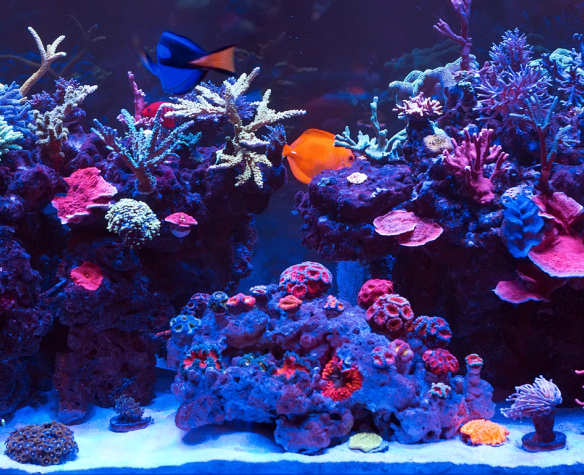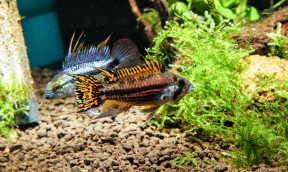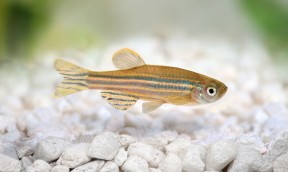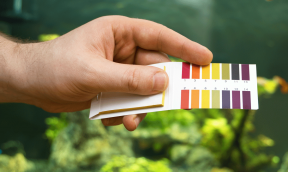
Fish Ailments and Solutions
Tropical fish do not have to be fragile. If provided with suitable, healthy living conditions, fish are able to withstand disease more easily.
Pathogenic agents thrive in sub-standard living conditions and develop on weak or stressed fish (due to transport).
If fish become sick, try to find out what disagreed with them in the aquarium and improve the environmental factors.
The ailing fish can then be treated. The ideal solution is to isolate them in a special aquarium (hospital tank).
Practical advice on administering a treatment:
- Keep the filtration system running
- Remove the activated charcoal from the filter if used
- Feed sparingly throughout the treatment period
- Follow the prescribed doses and administration conditions for the products
- Regularly monitor changing in nitrite concentration (if nitrite levels increase, change the water)
- Do a substantial water change (50%) at the end of treatment and replace the activated charcoal
- Add anti-nitrite bacteria to resume biological filtration
- Do not add new fish straightaway.
Diseases
- Viruses: there is no specific treatment. These are difficult to manage. E.g.: lymphocytosis is a viral disease.
- Pathogenic bacteria: these should not be confused with the good bacteria which play a role in filtration. These are microscopic single-cell organisms. Numerous diseases caused by pathogen bacteria often thrive in sub-standard water conditions. For example: Flexibacter columnaris causes cotton-mouth.
- Fungi: certain types grow on or in fish due to stress or injury, this is known as mycosis (fungus). For example: Saprolegnia causes water mould disease. Branchiomyces attach to the gills.
- Protozoa: these are single-cell organisms which often cause highly contagious, serious diseases resulting in heavy losses. For example: Ichthyophthirius multifiliis causes freshwater white spot disease. Pleistophora causes neon tetra disease.
- Worms: in order to breed, Digenea worms often need to be transmitted by animals other than fish, and are therefore rarely found in aquariums. However, some worms are directly transmissible among fish (Monogenea worms) and are therefore very hazardous in multi-species fish tanks. For example: Dactylogyrus, a microscopic worm which attacks the gills. Camallanus, which lives in the digestive tract in fish.
- Parasitic crustaceans: these often attach themselves to the skin or gills. For example: Lernaea or anchor worm, Argulidae or carp lice.
Bacterial diseases
- Infectious dropsy: causes swelling of the fish’s stomach. Scale protrusion is observed. There are variable causes. When caused by bacteria, dropsy is hazardous as it is contagious.
- Exophthalmos: The fish’s eyes protrude from the sockets. Same comments as for dropsy. However, exophthalmos is less contagious.
- Skin ulceration: Loss of scales, with erosion of skin, leaving a reddish hole which then turns white. Aeromonas is a bacteria which often causes this type of symptom. This is a serious disease as bacteria can invade the fish’s body.
- Mouth inflammation/secondary infection: the mouth becomes blistered and whitish, as though covered in mould. It then putrefies and turns black. Mouth rot is caused by Flexibacter columnaris. Other microbes then thrive and attack the fish.
- Fin rot and necrosis: the fins appear opaque, uneven and torn. Bacteria thrive in inadequate maintenance conditions and infect the fish.
White spot disease
This is a common aquarium disease. It is highly contagious and spreads rapidly.
Your aquarium is most probably infested with Ichthyophthirius multifiliis in a freshwater setting and Cryptocaryon irritans in a saltwater setting, protozoa which cause white spot disease.
Characteristics: the fish is covered with raised white spots, the size of a pinhead, over practically the whole body. Only the adult form, which is encysted beneath the skin, is observed in affected fish. However, in the aquarium, free forms rapidly proliferate before infesting the fish once again.

Fungi or mycosis:
Fungi contaminate fish when the skin, fins or gills are already damaged due to a bacterial or parasitic infection, or after an injury caused by fighting, capture or transport. In most cases, fungal infections are recognisable by the presence of white, grey or brownish cottony tufts on the skin or fins. Saprolegnia causes water mould disease. Branchiomyces attach to the gills.
Diseases caused by protozoa:
Velvet disease: fish appear to be covered with a brownish-yellow coating, as though sprinkled with gold.
This disease is caused by Oodinium, an agent similar to the organism responsible for white pot disease, but which has the distinctive feature of being a parasite also having the characteristics of algae. It can thus survive in aquariums for a long a time even when no fish are present.
Skin viscosity: the fish rub against decorative objects. A barely visible milky white coating is observed on the fish’s skin.
The fins are clearly pressed against the body. Respiratory disorders can sometimes occur in severe conditions. Several genuses of protozoa caused these types of symptoms. Weak or stressed fish are often affected and are a hazard to other aquarium inhabitants.



